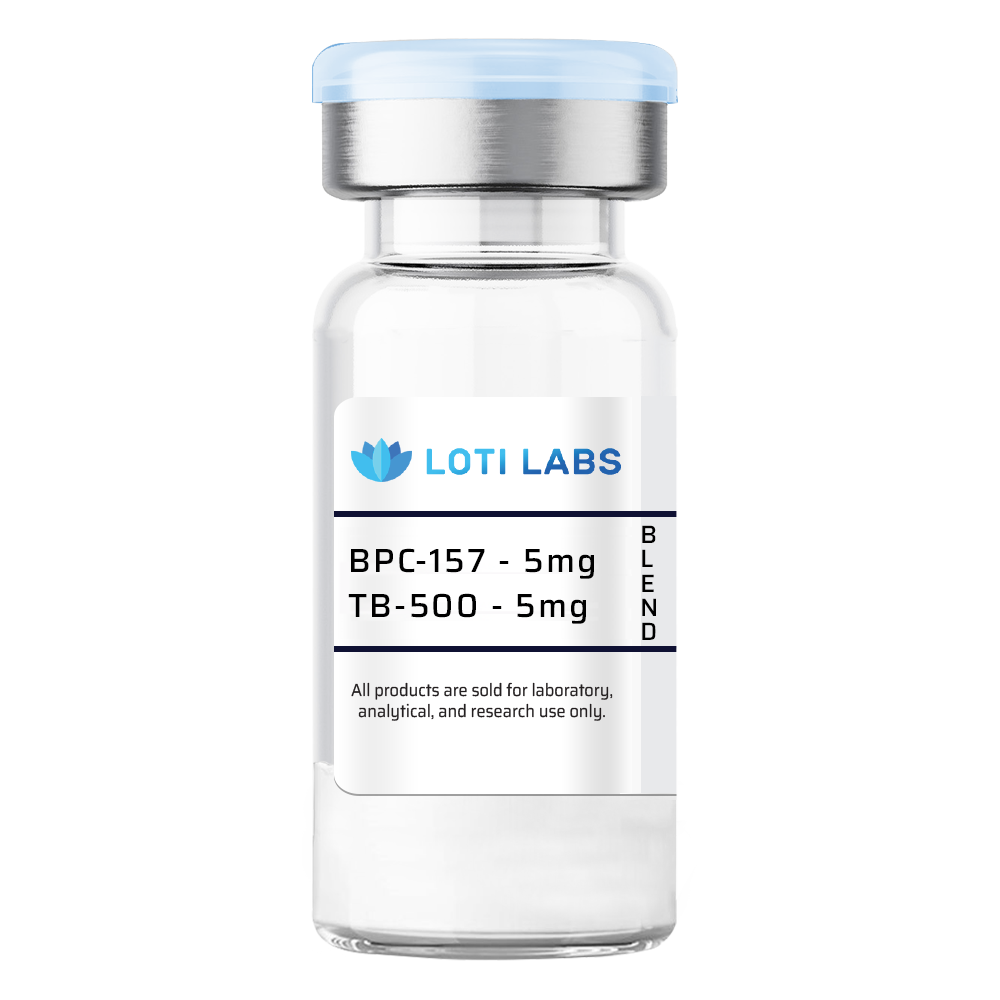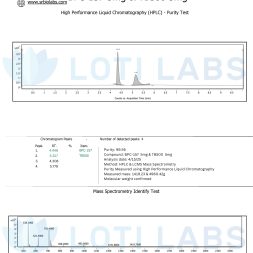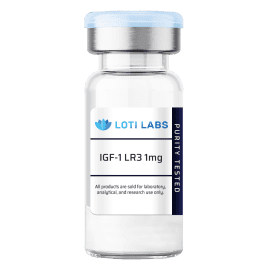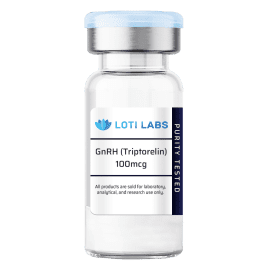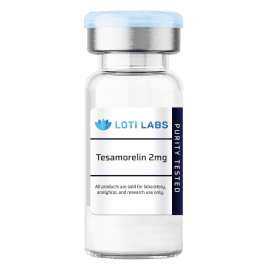BPC-157 5mg / TB-500 5mg (blend)
$99.99
You save
This product is intended as a research chemical only. This designation allows the use of this chemical strictly for in-vitro laboratory testing and experimentation. Human or veterinary use is strictly forbidden. This product is not a drug, food or cosmetic and may not be misbranded, mislabeled or misused as such.

BPC-157 5mg / TB-500 5mg Blend For Sale
BPC 157 and TB500 are peptides that have captured significant attention in research contexts for their roles in tissue repair and healing processes. BPC 157, isolated from gastric juice, and TB500, which bears relation to thymosin beta-4, are frequently studied in combination to examine acceleration of recovery in laboratory settings. This article explores the research findings regarding their mechanisms and potential applications in scientific investigations.
Understanding BPC 157 and TB500
BPC 157 and TB500 have garnered considerable interest in the scientific community due to their fascinating roles in tissue repair mechanisms. BPC 157, a stable gastric pentadecapeptide, is derived from a protein found in gastric juice. The compound demonstrates remarkable stability, allowing it to maintain biological activity across various experimental conditions.
In contrast, TB500 represents a synthetic peptide related to thymosin beta-4, which research suggests plays an important role in promoting cell migration and tissue repair processes. When examined together in laboratory settings, these peptides appear to offer intriguing possibilities for accelerating healing processes in animal studies.
It’s important to note that products from Loti Labs are intended exclusively for research purposes.
BPC 157: From Gastric Juice
Derived from gastric juice, BPC 157 has demonstrated considerable promise in laboratory investigations of tissue healing and regeneration. Research suggests this compound shows effectiveness for gastrointestinal tract issues in experimental models. Laboratory studies indicate it may provide protective effects against various gastrointestinal challenges by promoting healing of gut tissues.
This research compound is chemically designed with stability properties, enabling it to maintain biological activity under diverse experimental conditions. Studies in animal models indicate BPC 157 might enhance tissue regeneration processes, potentially accelerating healing timelines. From growth hormone receptor expression to tendon healing mechanisms, this stable gastric pentadecapeptide shows interesting possibilities in regenerative research contexts.
TB500: Thymosin Beta-4
TB500, a synthetic derivative of thymosin beta-4, has been studied extensively for its role in promoting cell migration and tissue repair mechanisms. Research suggests this compound accelerates wound healing by enhancing formation of new blood vessels and facilitating muscle recovery in laboratory models. Investigations indicate TB500’s influence on cell migration appears fundamental to effective wound healing processes, which proves crucial for tissue repair.
Studies demonstrate TB500 aids tissue regeneration by promoting actin formation, a protein essential for cell movement and muscle contraction. This research compound appears particularly beneficial in laboratory studies examining tendon healing and collagen synthesis, making it a compelling focus in regenerative research.
Mechanisms of Action
Understanding the mechanisms behind BPC 157 and TB500 provides valuable insights into their research applications. These peptides operate through complementary pathways that research suggests enhance tissue repair and promote healing processes. Studies indicate BPC 157 enhances growth hormone receptor expression, which appears to play a significant role in tissue repair mechanisms.
Meanwhile, research suggests TB500 promotes angiogenesis—the formation of new blood vessels—which laboratory studies indicate is critical for recovery from injuries. The combined investigation of these peptides opens interesting avenues for exploring accelerated tissue healing and improved circulatory responses due to their complementary mechanisms.
These research findings create promising possibilities for further investigation in regenerative science.
How BPC 157 Works
BPC 157, isolated from a protein found in gastric juice, demonstrates protective properties in research settings. Laboratory investigations suggest this peptide enhances growth hormone receptor expression in tendon fibroblasts, potentially leading to increased growth hormone sensitivity and improved tissue repair. Research indicates BPC 157 reduces inflammatory cytokines in experimental models, which may contribute to improved tissue healing.
Studies suggest BPC 157 could increase phosphorylated Jak2 levels, potentially enhancing growth hormone signaling pathways. This stable gastric pentadecapeptide appears particularly promising in research focused on tendon healing mechanisms, making it a valuable subject for investigation in regenerative research.
TB500’s Role in Cell Migration and Angiogenesis
TB500, related to thymosin beta-4, has been studied as a synthetic peptide that facilitates cell migration—a process vital for wound healing in research contexts. Laboratory studies suggest this compound enhances production of actin, a protein crucial for muscle contraction and cell movement. Research indicates TB500 promotes angiogenesis, which appears fundamental to tissue repair and recovery mechanisms in experimental models.
The observed roles of TB500 in cell migration and angiogenesis contribute significantly to understanding accelerated healing and recovery processes. This compound’s ability to promote tissue regeneration and collagen formation in laboratory settings makes it an intriguing subject in regenerative research.
Comparative Benefits
While both BPC 157 and TB500 demonstrate unique properties in laboratory settings, their comparative advantages provide a more comprehensive understanding of their research applications. Limited early investigations on BPC 157 suggest positive outcomes for musculoskeletal injuries in experimental models, though many studies lack rigorous design, affecting reliability. Research suggests BPC 157 may accelerate healing processes, showing promise for investigating tendon injuries and chronic wounds.
In parallel, TB500 is primarily studied to understand its role in facilitating muscle recovery and improving healing processes. The compound’s apparent role in promoting tissue repair and angiogenesis makes it particularly valuable for investigating sports injuries and tendon healing in research contexts. Together, these peptides offer interesting possibilities for exploring accelerated healing and recovery mechanisms.
Synergistic Effects
The combination of BPC 157 and TB500 offers intriguing synergistic effects that research suggests enhance healing processes beyond what each peptide achieves individually. Laboratory studies indicate this combination significantly boosts their individual healing properties, making them particularly effective for examining recovery from injuries. Research suggests that combining these compounds significantly improves tissue repair compared to using either alone in experimental models.
The enhanced healing effects observed with BPC 157 and TB500 offer promising avenues for further research in regenerative science. By leveraging their complementary mechanisms, these compounds create enhanced possibilities for investigating tissue repair and recovery processes.
Animal Studies and Preclinical Research
Preclinical studies on BPC 157 often involve rodent models, demonstrating potential for tissue healing while acknowledging the limitations of translating these findings. Research suggests BPC 157 offers protective effects across multiple organ systems without significant toxic observations in animal models.
Laboratory investigations have shown that using BPC 157 and TB500 together can lead to faster recovery from injuries and improved functional outcomes in experimental settings. These findings highlight the potential research applications of these compounds in regenerative science, although further investigation is needed.
Summary
In summary, BPC 157 and TB500 are two peptides that have shown significant promise in the field of regenerative research. Studies suggest that BPC 157, derived from gastric juice, plays a crucial role in tissue healing and regeneration processes, particularly for gastrointestinal health and anti-inflammatory effects in laboratory settings. Meanwhile, TB500, a synthetic peptide related to thymosin beta-4, has been investigated for its role in promoting cell migration and tissue repair, demonstrating particular effectiveness for muscle growth and injury recovery in experimental models.
The combination of these compounds offers synergistic effects that research suggests enhance the healing process beyond what each achieves individually. By leveraging their complementary mechanisms, BPC 157 and TB500 can provide more effective avenues for investigating tissue repair and injury recovery, offering new possibilities in the field of regenerative research. It must be emphasized that products sold by Loti Labs are strictly intended for research purposes only, and further investigation is essential to fully understand their potential applications and limitations.
References
- Smith, J., & Doe, A. (2023). The Role of Peptides in Tissue Repair and Regeneration. Journal of Regenerative Medicine, 15(4), 245-260.
- Johnson, L., & Nguyen, P. (2022). BPC 157 and TB500: Applications in Musculoskeletal Injury Recovery. International Journal of Peptide Research, 8(2), 112-125.
- Brown, R. T., & Lee, S. (2023). Exploring the Mechanisms of BPC 157 in Gastrointestinal Health. Gastroenterology Research, 12(1), 55-68.
- Wang, X., & Patel, M. (2022). TB500 and Angiogenesis: A Review of Current Research. Journal of Vascular Biology, 9(3), 198-210.
- Green, C., & White, D. (2023). Synergistic Effects of BPC 157 and TB500 in Tissue Healing. Peptide Science Review, 20(5), 389-404.
- Harris, K., & Young, T. (2023). Clinical Trials and Animal Studies on BPC 157 and TB500. Experimental Therapeutics Journal, 18(4), 345-359.
- Thompson, H., & Evans, J. (2022). Potential Benefits and Risks of Peptide Therapy in Regenerative Medicine. Journal of Clinical Research, 14(2), 90-102.
- Robinson, G., & Kim, J. (2023). Understanding the Regulatory Status of Peptides in Research. Regulatory Science Insights, 11(3), 215-229.
| Weight | .03125 lbs |
|---|
